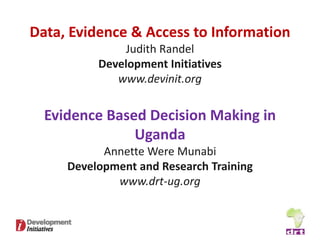
Data, evidence and access to information
- 1. Data, Evidence & Access to Information Judith Randel Development Initiatives www.devinit.org Evidence Based Decision Making in Uganda Annette Were Munabi Development and Research Training www.drt-ug.org
- 2. Development Initiatives – the Role of Data in Decision Making Development Initiatives: • An independent organisation working for the eradication of absolute poverty • Our mission is to empower and enable people to make evidence-based and data-informed decisions to deliver more effective use of resources for poverty eradication • Produce accessible data, analysis and infographics • Offices in Bristol (UK), Nairobi (Kenya) and through our partnership with Development Research and Training in Kampala (Uganda)
- 3. Funding According to Need GHD 6: Allocate humanitarian funding in proportion to needs and on the basis of needs assessments. As a minimum, to meet those principles you have to be able to assess needs in a comparable way and you have to know what resources are available – not just GHD 11: Strive to ensure that funding of humanitarian action in new crises does not adversely affect the from your own meeting of needs in ongoing crises. budget, but from other sources too
- 4. Drivers of Humanitarian Funding Decisions 1. What we did last year plus or minus 10% 2. The bottom line – how much does the donor have to spend Good News: quality and availability of information on risk, vulnerability and humanitarian needs is improving (DO WE WANT TO PUT IN SOME EGs or REFERENCES here???) Good News: some donors are using this information to systematically inform decision making Sweden, the CHF, the EC, OFDA Issue of Concern: strongly held beliefs demonstrably drive resource allocation, which in turn influences the way that needs are articulated.
- 5. A Case Study: Northern Uganda What are the humanitarian needs? Who are the key actors? What role do they play? In 2010: Uganda was the 23rd recipient of official The Government has played a major role: humanitarian aid in providing security Only 4.8% of total aid ($1.7bn) to Uganda was creating a conducive environment for socio- for humanitarian response economic activity coordinating humanitarian actors The most frequent disasters: as a channel of aid Displacement of people Famine Partners – NGOs, donors, CBOs, FBOs, private and Earthquakes charity organisations – have: Epidemics Provided financial and technical support Livestock and crop diseases Delivered services Floods Landslides The role of affected communities is to: Participate in the delivery (& design????) of the response Build confidence and trust
- 6. The flow of information to and from affected communities in Northern Uganda
- 7. How can we achieve better outcomes? Activities to improve the decision making of humanitarian actors Establish and strengthen community based information systems Ensure the feedback loop is closed Assist key actors to adopt the open data initiative Obstacles/Barriers Training and capacity building on using data Though evidence from affected incorporating evidence communities is increasingly demanded at the global level, Involve beneficiaries in the design, delivery demand from national and local and monitoring of responses will help identify level decision makers remains low root causes/problems Investment in data, evidence and Link community based information systems information systems is currently (CBIS) to sectoral and national level MIS low Volunteer sector based community groups Require the Government to should be utilised to gather on-site evidence provide a basic minimum package of information to be shared by all
- 8. Discussion Topics • Given the poor quality of much information and the range of legitimate and other influences on decisions, are our expectations of ‘evidence- based’ decision making too high? Should we just aim for transparent ‘data-informed’ decisions? • Can we make more use of technologies to gather, publish and aggregate information? • How much priority should be given to strengthening management information systems starting with community based systems for improved humanitarian and development outcomes? • Human intelligence, judgement and experience play a critical role in decision-making: is this sufficiently recognised in the context of the drive for evidence-based decisions?
